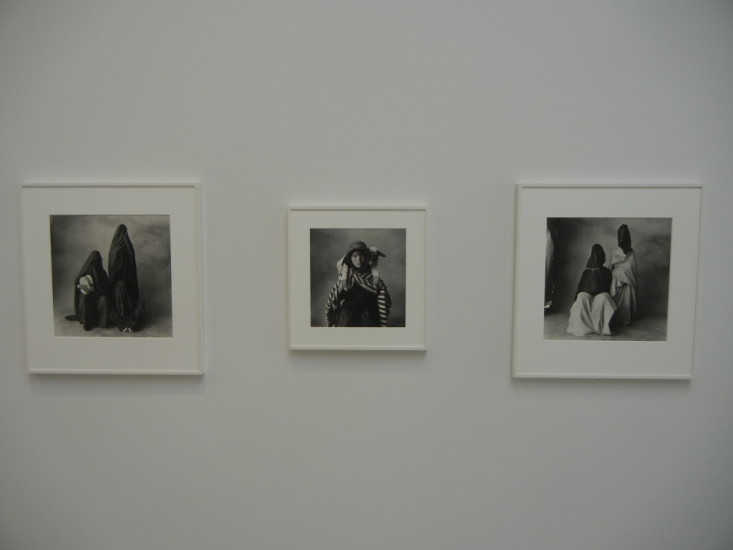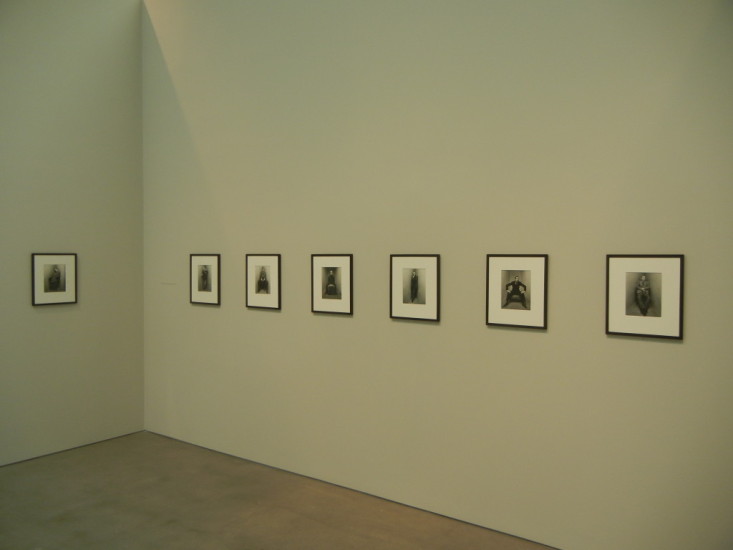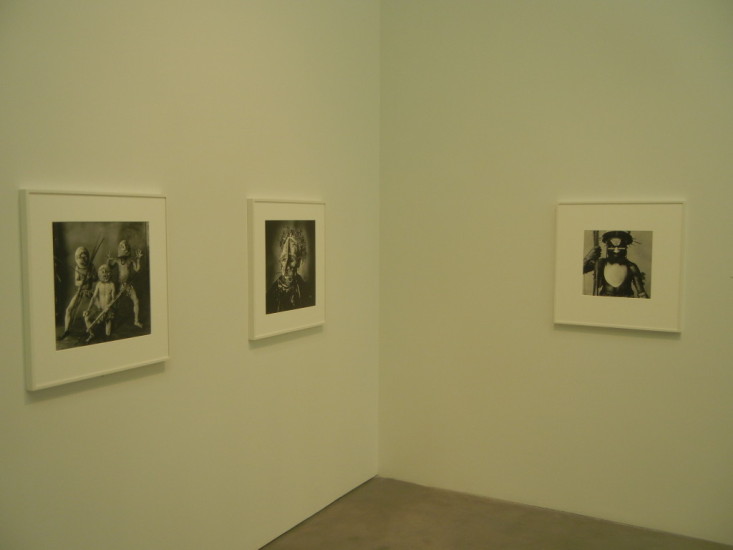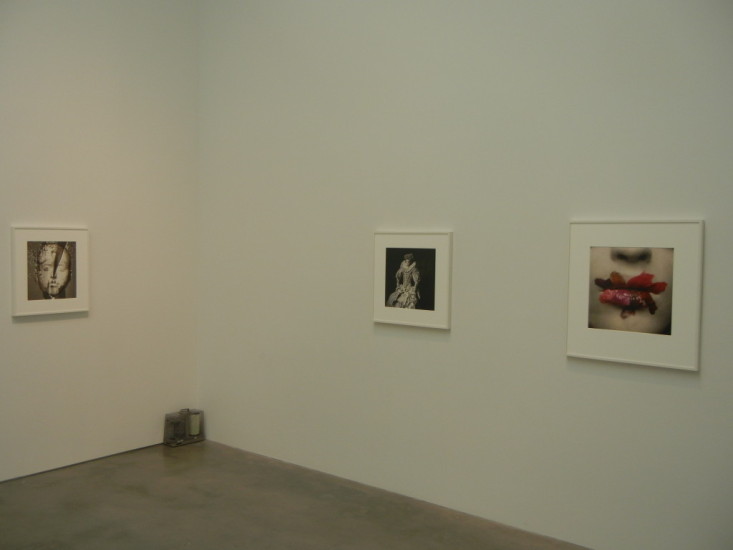JTF (just the facts): A total of 65 black and white and color photographs, variously framed and matted, and hung against white and grey walls in a series of 5 divided spaces. The show also includes three vitrines with Vogue magazine covers, Vogue magazine spreads, and working photo albums. While organized by Pace/MacGill, the show takes place at Pace’s gallery space at 510 West 25th Street. (Installation shots below, in a slideshow.)
Penn used a variety of photographic processes over the years, and the exhibit contains examples of no less than five different kinds of prints. Listed below are the number of prints on view in each process, along with dates, sizes and other supporting details:
- 46 gelatin silver prints (vintage and later, 1947-2007, sized between 8×7 and 22×20, in editions of 6-60, some mounted to board)
- 6 platinum palladium prints (vintage and later, 1948-1996, sized between 17×15 and 22×20, in editions of 25-60, mounted to aluminum)
- 6 dye transfer prints (vintage and later, 1947-1995, sized between 19×15 and 23×18, in editions of 18-33, some mounted to board)
- 4 pigment prints (vintage, 2005-2008, sized between 13×21 and 24×24, in editions of 8-26, mounted to board)
- 3 Fuji Crystal Archive prints (vintage, 2001-2003, sized between 15×24 and 36×30, in editions of 6-15, some mounted to board)
Comments/Context: When compared with its big brother, Fine Art Photography in capital letters, commercial photography (work made on assignment for newspapers, magazines, catalogs and other printed publications and businesses) has often struggled to get the same recognition as its more respected sibling. For some intractable and largely illogical reason, we seem to immediately discount work made for hire as somehow less artistic or creative, even though we have countless examples across the history of the medium of iconic photographs made in professional contexts, especially fashion and photojournalism. But this comprehensive show of Irving Penn’s sixty year career of commercial work is the kind of museum-quality exhibit that should silence the naysayers and serve as inspiration for all those working photographers out there trying to turn a freelance shoot into something transformative. Time and time again with staggering consistency, Penn put his distinctive imprint on unlikely subjects, turning the “done before” into something truly astonishing.
For those familiar with Penn’s work, there aren’t actually that many surprises on view here, but this doesn’t diminish their collective power. Small groups of images from a variety of generally well known projects are used to illustrate Penn’s visual innovations, and the sampler approach is effective in showing off his diversity and range. When seen together, his meticulous perfectionism and insistence on clean spare compositions comes through clearly; whether working on a portrait, a still life, or a fashion spread (none of his own choosing), his eye tended toward the quietly elegant, paring back distractions and allowing the viewer to be drawn directly into the central subject.
Penn’s portraits are full of subtle compositional originality, often isolating a sitter in an unobtrusive middle grey setting to force the viewer look more closely. The Small Trades series highlights the uniforms and tools of various occupations (the plasterer, the steel mill fire fighter, the tree pruner), while his ethnographic portraits from Morocco, Cuzco, Dahomey, and New Guinea expose us to the unexpected beauty of native and tribal dress with same respect afforded designer fashions. Large groups (rock stars, artists, ballet dancers) were subjected to similar treatment, each image a collection of faces telling a particular story of exceptionalism. And Penn’s corner portraits upended the standard notion of the celebrity portrait, pushing artists, musicians, and writers back into a tightly angled space, creating new opportunities for insightful individual poses. With professional regularity, he took straightforward portrait assignments (Miles Davis, for example) and emerged with something both visually new and durably insightful (the iconic, almost sculptural shots of Davis’ finger positions on his trumpet).
Penn’s still lifes exhibit the same exacting sense of economy, eliminating the extraneous and turning a jumble of objects into a symphony. The works on view here balance his classicism (the chaotic perfection of salad ingredients or pocket contents at the theatre) with the more innovative and extreme of his compositions, from the iconic frozen vegetables to the expressive exaggeration of fashion accessories (lips covered in a dozen shades of lipstick, a blood shot eye with thick mascara, a milk splash on a model’s face, a bee perched on red lips). The show actually delivers Penn’s parade of fashion knockouts with a light touch, paring the selection down to a handful of deserving icons (the harlequin dress, the Moroccan palace, the elbow roses), a few recent smashes (Cate Blanchett as Elizabeth and the elaborate red feathered headpiece with a Galliano jacket), and a vitrine of Vogue covers.
A sixty year career filled with amazing commissioned images like these could not have occurred without a relentless sense of precision, and a few of the wall texts allude to Penn’s unyielding attention to the details. But in the end, it is the graceful intelligence of his photographs that makes them so successful. Regardless of what was placed before his camera, Penn found refinement and dignity, bringing out the formal high style in everything from grungy rock stars to melting cheese. This show is a well deserved celebration of commercial excellence, and a reminder that a great artist can often unlock the extraordinary, even when it is tucked away in unlikely places.
Collector’s POV: The works in this show are priced between $17000 and $600000, with many prints NFS. Penn’s prints are ubiquitous in the secondary markets, with dozens of examples available every season. Prices have ranged from $8000 to $460000 in recent years, with prices steadily increasing since the artist’s death in 2009.





















